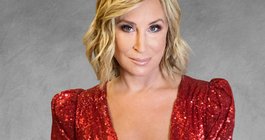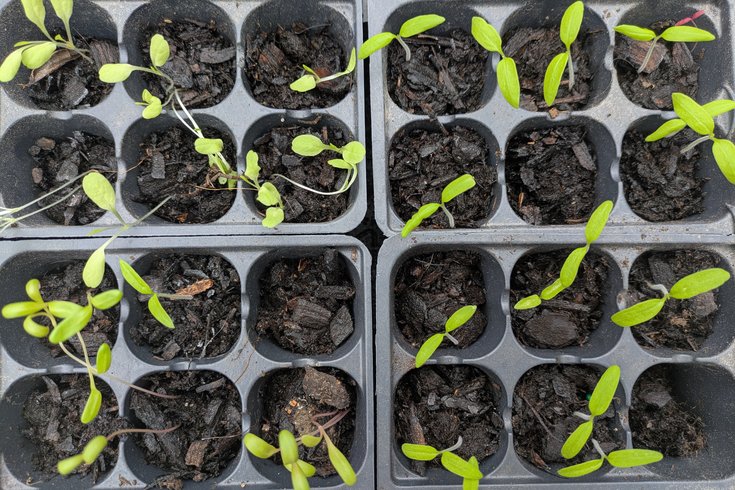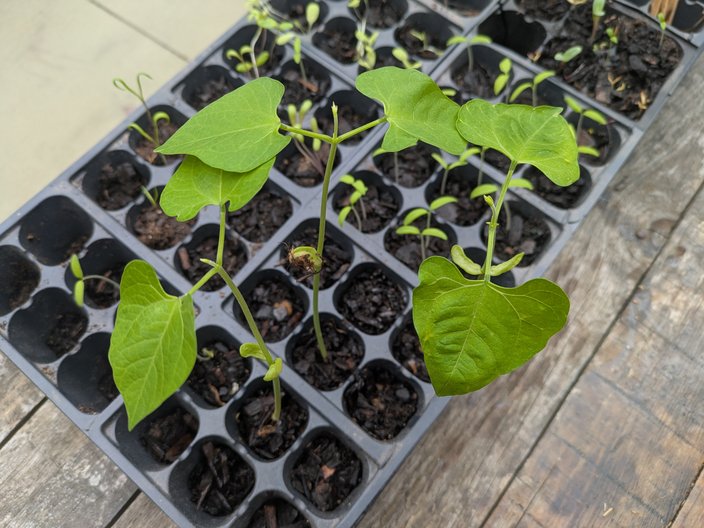
March 28, 2025
 Michaela Althouse/PhillyVoice
Michaela Althouse/PhillyVoice
When planting from seed, expert gardeners say timing, preparedness and environmental conditions are key. Above, young spinach, tomato and lettuce plants.
It's the time of year when windowsills are filled with grids of baby plants and kitchen tables are taken over by grow lights.
Every spring, many home gardeners begin planning for the months ahead by planting seeds indoors to save costs and prolong the growing season. But that method can also be a lot more intimidating than buying mature plants from the hardware store, especially for anyone who has struggled in the past with seeds that never spouted or young plants that shriveled up once they were placed outside.
To help avoid the pitfalls, experts from Philly's Truelove Seeds, Experimental Farm Network, Burpee Seeds and the Pennsylvania Horticultural Society shared their advice for when, where and how to turn a springtime seed into a full-grown plant for the summer table. Whether it's for urban container gardening or a plot of land, they said growing can be as simple as placing a few seeds in an egg carton in a windowsill.
Owen Taylor, the owner of Philadelphia seed preservation company Truelove Seeds, usually begins planting his cool weather crops like peas, fava beans and potatoes directly into the ground around the first day of spring and into mid-April. For other kinds of edible plants, it's important to start them off indoors to extend the growing season as long as possible.
Nightshades like tomatoes, eggplants and peppers should begin life inside in March and April because they're slow to sprout and take a long time to mature. Slower-growing herbs like mint, lavender and thymes can be planted in early spring, but faster ones like basil should wait until April. Other crops such as cabbage, kales and brassicas can be planted outside but tend to do better if they're started in a window or under grow lights so they're stronger for the summer heat, Experimental Farm Network co-founder Nate Kleinman said.
"With certain seeds, in our climate it's pretty important to start them early if you want to get a good crop," Kleinman said. "Otherwise, the season is just too short and they won't have enough time to get big and strong before the summer heat sets in."
If sowing warm weather crops directly in the ground is preferable, Taylor suggested waiting until the last danger of frost has passed and the soil heats up to around 50 to 60 degrees at night. Usually, that's after the second week in May.
Seeds prefer to be damp in the soil, but not so wet that mold or fungi can grow, so it's important to water consistently without overdoing it. A specific seed-starting soil mix, which is sold at hardware stores and nurseries, can help moderate moisture and maintain ideal conditions. Plant stores also sell specific ingredients to DIY. The Experimental Farm Network uses a mix of Canadian peat, perlite and dolomitic lime powder, which helps balance the soil's pH.
"People assume that they can use any old potting soil or even just soil from the garden to start their seeds, but that is often not the case," said Kleinman, adding that the wrong soil often leads to damping off, when seedlings shrivel up and die.
Many seeds are also triggered to sprout with warmer temperatures, so some gardeners opt for putting a heating pad underneath their plantings or placing a transparent cover like plastic wrap above them for a greenhouse effect. Kleinman said the same effect can be achieved by placing trays or egg cartons in a window above a radiator or heating vent.
Light is also key, so south- and west-facing windows are ideal. Nancy Awot-Traut, a horticulture specialist at Burpee, said seedlings should have a light source within 4 inches of top of the plant. If opting for grow lights, they should be on for 16 hours and off for eight.
Still, keeping it simple can work just as well, Kleinman said.
"All of that stuff is not strictly necessary," Kleinman said. "An egg carton with good seed-starting mix on a sunny, south-facing windowsill is pretty much ideal for a whole lot of different crops."
Since it's rare that 100% of seeds will germinate, he recommends planting more than necessary and eventually selecting the best, healthiest-looking seedlings to bring outside. But he also noted that less is more when working with a small space, since plants need room to grow — one tomato plant will produce more fruit than 12 plants within the same square foot, he said.
After they're in the egg carton or seed tray, Taylor suggested labeling not only what each seed is, but also the day that it was planted. That way, growers can look up the common germination day for each type of plant and diagnose an issue if they don't sprout accordingly.
The experts said which seeds to pick often depends on personal preferences — Taylor said Truelove encourages gardeners to look into the plants that might have fed their ancestors for a familial touch. But the growers said it's also important to consider available space, as some species grow better in containers than others. (Kleinman, though, said he thinks anything besides grain crops is worth a try in a container since plants will grow into the space they're in).
Once which type of fruit or vegetable has been determined, gardeners may also have to decide between different varieties, like a dwarf plant that's better for small spaces or an heirloom seed versus a hybrid. Heirlooms, which are older varieties that have been saved over generations, aren't bred for high-production or other desirable qualities such as shelf life in the same way as their hybrid counterparts. But, Taylor said, they were from a time when taste was high-priority.
"A lot of times, heirlooms maybe can't ship 3,000 miles and still be beautiful, but you can pick them in your garden and they'll be far more delicious than the hybrids or even genetically modified foods you can find now in the store," Taylor said. "Growing heirlooms is going to be a really different flavor experience."
Some heirlooms can be less disease-resistant than their modified counterparts, so Taylor said a good place to start for new gardeners is easier crops like greens, carrots or beets. They grow quickly, so there's less time for problems to arise, although he said there is a certain satisfaction that comes from growing fruiting plants if you're up for a challenge.
"Growing peppers and tomatoes is really gratifying, too, and you can be so proud of yourself once the fruits start ripening and you can bring them to the kitchen and start using them," Taylor said. "So I wouldn't shy away from growing some of those from seed, they just take a few more steps because you have to start them indoors and you have to wait longer, but I think it's worth it."
 Michaela Althouse/PhillyVoice
Michaela Althouse/PhillyVoiceSeedlings, like the ones above, are ready to be moved outdoors when they have multiple sets of leaves.
When they have at least two sets of leaves, Taylor said seedlings are mature enough to move outside. But they might need a few more days before they're actually ready to go in the ground. Seeds started indoors might not be used to stress like direct sunlight and wind, so most gardeners recommend a process called hardening off, which involves putting the young plants outside during the daytime and taking them back in at night for a few days.
While they're still inside or in a greenhouse, though, Taylor and Kleinman said having a fan blowing on them or opening a window can help get plants used to the elements.
"Some people will brush their hands gently across their seedlings to get them stronger — it's kind of like a workout for the plants so that they're not too weak for the wind," Taylor said.
When they're ready for the official planting, it's still important to ease the seedlings into the ground and avoid shock as much as possible. Kleinman tries to do it on mild, partially cloudy days, or waits until the late afternoon or early evening if it's a sunny and warm day so a young plant can get its footing.
"Taking plants right out and putting them in the heat of the sun is a recipe for disaster," Kleinman said.
When container gardening, all the experts suggested finding the biggest containers possible, especially for larger plants like tomatoes, peppers and eggplant. Pots that are 16-24 inches are ideal to optimize root space, which will increase production, and reduce watering needs.
"You see in a lot of parts of Philly people growing in a huge amount of pots, even five-gallon buckets and bathtubs and stuff like that," Taylor said. "You can get quite a lot of production from pots."
Similar to houseplants, outdoor gardens should be watered when the soil is dry below the surface. In the hottest part of the summer, this can occur daily, especially for containers. Pots on a roof or deck could scald from sun exposure in particularly bright areas, and some gardeners opt for protective shade cloth.
Saucers should also be placed underneath a container to keep soil moist while preventing water buildup, which can cause root rot.
"It is critical to find a container with drainage holes because it is imperative that there is always good drainage," said Andrew Bunting, vice president of horticulture at the Pennsylvania Horticultural Society.
For those planting directly into the ground, soil should be tested to ensure ideal conditions. However, Philadelphia soil can contain toxins such as lead from old paint or industrial operations. In that case, the city recommends raised beds or putting down landscape fabric and adding fresh soil and compost.
Some people opt to trade leftover seeds with neighbors or friends to keep initial costs down, but most seeds can be stored for a few years before they stop producing. Taylor suggested placing the remains in airtight containers and storing them on a shelf or closet, out of direct sunlight and free from temperature fluctuations and humidity.
"With a few exceptions, like the onion family or parsnips ... almost everything else will (last) three or four years, if not longer," Taylor said.
At the end of the season, Kleinman also suggested trying to save a few seeds from the mature plants for next year. Some might need to be left alone for a few weeks to produce seeds, but others like tomatoes and peppers can be pulled from a fresh fruit.
"That's something that a lot of growers don't do, but it can be a really powerful way to increase your own food sovereignty and also help preserve culturally important seeds for you and your community," Kleinman said.